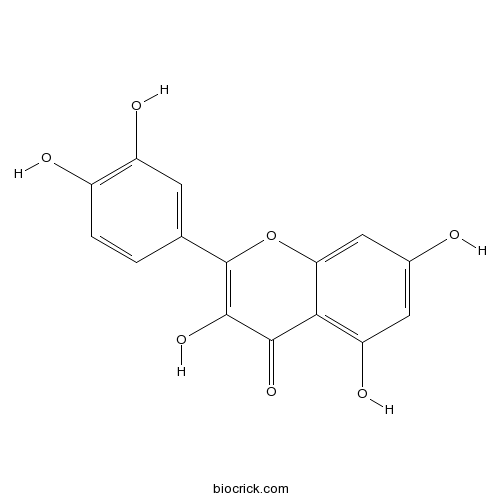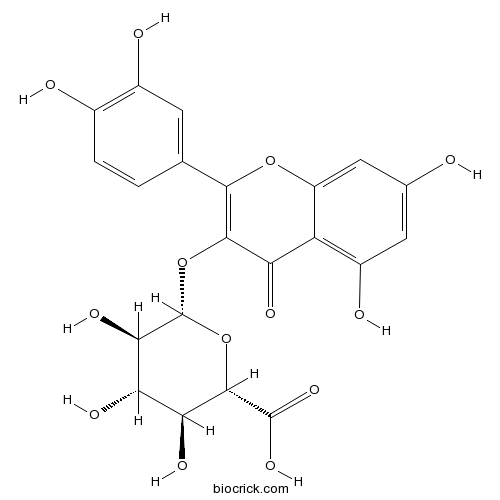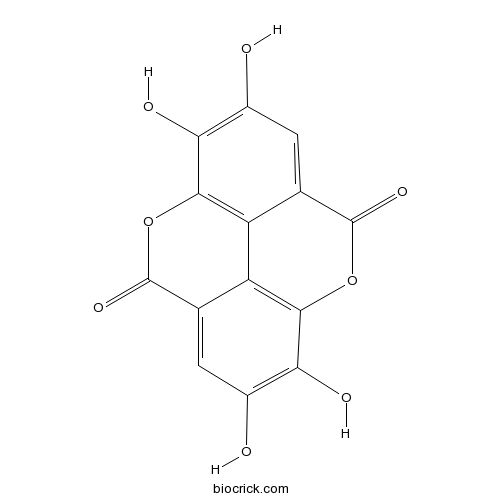Polygonum perfoliatum
Polygonum perfoliatum
1. The products in our compound library are selected from thousands of unique natural products; 2. It has the characteristics of diverse structure, diverse sources and wide coverage of activities; 3. Provide information on the activity of products from major journals, patents and research reports around the world, providing theoretical direction and research basis for further research and screening; 4. Free combination according to the type, source, target and disease of natural product; 5. The compound powder is placed in a covered tube and then discharged into a 10 x 10 cryostat; 6. Transport in ice pack or dry ice pack. Please store it at -20 °C as soon as possible after receiving the product, and use it as soon as possible after opening.
Natural products/compounds from Polygonum perfoliatum
- Cat.No. Product Name CAS Number COA
-
BCN6049
Quercetin117-39-5
Instructions

-
BCN3149
Quercetin-3-O-glucuronide22688-79-5
Instructions

-
BCN5533
Ellagic acid476-66-4
Instructions

-
BCN5771
Avicularin572-30-5
Instructions

Physiological response of Polygonum perfoliatum L. following exposure to elevated manganese concentrations.[Pubmed: 28035610]
None
The flavonoid from Polygonum perfoliatum L. inhibits herpes simplex virus 1 infection.[Pubmed: 25518720]
Herpes simplex virus 1 (HSV-1) is one of the most prevalent human pathogens in both industrialized and developing countries. This study was performed to analyze the antiviral activity of purified flavonoid from Polygonum perfoliatum L. against HSV-1 infection in vitro and in vivo. Flavonoid showed no inhibitory effect, when treated before virus infection, but it strongly inhibited viral replication and cell-to-cell spread which was vital for the virus's propagation. The therapeutic effect of the flavonoid in treating HSV-1 induced encephalitis was also investigated in mice. A dose-dependent increase of survival rate and mean survival time (MST) were observed in the flavonoid-treated mice. These results suggested that the flavonoid may be a viable therapeutic option for recurrent HSV-1 infection.
Simultaneous determination of esculetin, quercetin-3-O-β-D-glucuronide, quercetin-3-O-β -D-glucuronopyranside methyl ester and quercetin in effective part of Polygonum Perfoliatum L. using high performace liquid chromatography.[Pubmed: 25210326]
In the present study, a high performance liquid chromatography (HPLC) coupled with photodiode array detection was developed for simultaneous quantitation of esculetin, quercetin-3-O-β-D-glucuronide, quercetin-3-O-β-D- glucuronopyranoside methyl ester and quercetin in Polygonum perfoliatum L.
[Chemical constituents of ethyl acetate extract from Polygonum perfoliatum].[Pubmed: 23252271]
To study the chemical constituents of Polygonum perfoliatum.
[Quality evaluation of wildlife tending Polygonum perfoliatum].[Pubmed: 22803356]
To evaluate the quality of Polygonum perfoliatum collected from GAP planting base efficiently so as to provide scientific evidence for its GAP tending plant by HPLC fingerprinting method.
A new lignan with anti-tumour activity from Polygonum perfoliatum L.[Pubmed: 22533633]
The methanol extract of the tubers of Polygonum perfoliatum L. afforded a new lignan: 8-oxo-pinoresinol (1), and five known compounds 3',5-dihydroxy-3,4',5',7-tetramethoxy-flavone (2), catechin (3), quercetin (4), quercetin-3-O-β-D-glucuronide (5) and rutin (6). Their structures were established by MS, one- and two-dimensional NMR experiments. Compound 1 showed cytotoxicity against human mammary carcinoma (Bcap-37), human colon carcinoma (RKO), human hepatocellular carcinoma (SMMC-7721), human prostate carcinoma (PC3) and human erythroleukaemia (K562) cells.
Anti-inflammatory, antiviral and quantitative study of quercetin-3-O-β-D-glucuronide in Polygonum perfoliatum L.[Pubmed: 21570451]
Quercetin-3-O-β-D-glucuronide, isolated from Polygonum perfoliatum L., was evaluated by antiviral efficacy against influenza A virus and anti-inflammatory activity in vivo in mouse, and it was used for quality evaluation of P. perfoliatum L.. In vivo study, oral administration of quercetin-3-O-β-D-glucuronide significantly suppressed ear edema induced by dimethyl benzene and peritoneal permeability induced by acetic acid in mice, and quercetin-3-O-β-D-glucuronide also showed to possess inhibitory activity against influenza A virus (FLUAV). In the present study, additionally, a rapid, simple and sensitive method for quantitative analysis of quercetin-3-O-β-D-glucuronide in P. perfoliatum L. was developed using high performance liquid chromatography (HPLC) coupled with photodiode array detection. The separation was carried out on a Lichrosher-C18 column (250 mm × 4.6mm, 5 μm) together with a C18 guard column at isocratic elution systems of methanol (A) and 0.05% aqueous phosphoric acid (B) (43:57, v/v) with detection wavelength at 258 nm and column temperature at 30°C. The method was validated for linearity, repeatability, limit of quantification (LOQ), precision and robustness. The contents of quercetin-3-O-β-D-glucuronide in 28 samples from different regions of China were between 0.06% and 2.09%. The developed analytical method was applied to investigate P. perfoliatum L. and for quality control of the herb.
Neoflavonoids from Polygonum perfoliatum.[Pubmed: 17260292]
Four neoflavonoids, 3,4-dihydro-4-(4'-hydroxyphenyl)-5,7-dihydroxycoumarin (1), 3,4-dihydro-5-hydroxy-7-methoxy-4-(4'-methoxyphenyl)coumarin (2), 3,4-dihydro-5-hydroxy-4-(4'-hydroxyphenyl)-7-methoxycoumarin (3), and 3,4-dihydro-5,7-dihydroxy-4-(4'-methoxyphenyl)coumarin (4), were isolated from the whole plant of Polygonum perfoliatum. Neoflavonoids 1, 2, and 4 were known compounds, but 3 is a new member of this class.


